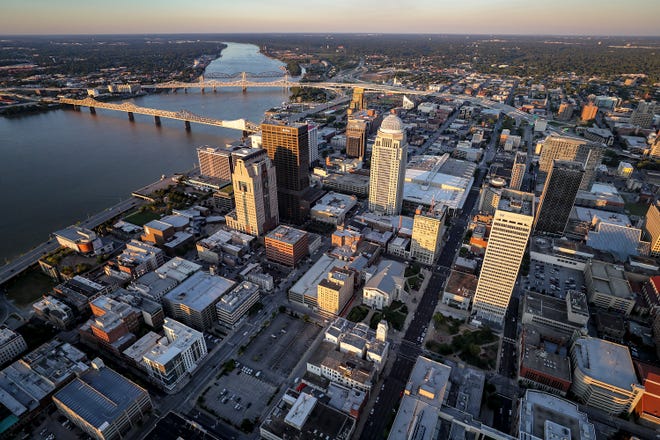More affordable housing. A reimagined Belvedere. Increased support for new businesses. A new, cohesive city-wide branding.
All of these ideas and dozens more are pitched in an extensive new report aimed at strengthening Louisville for its current residents and elevating the city’s profile on the national stage to spur further population and economic growth.
The draft report, released Thursday by Mayor Craig Grenberg’s office, makes the case that while Louisville has rich resources, it faces “lackluster” population trends, disjointed economic development efforts, and racial disparities in poverty, degree attainment, and labor force participation rates.

“Louisville has unique competitive advantages but has not communicated them well or capitalized on them,” the report reads.
With a key focus on bolstering local talent while attracting new residents and investment to Louisville, the report lays out some big goals: Double the city’s growth rate, leading to 1 million residents by 2038; create at least 300 Black-owned businesses by 2027; and increase venture capital investment by 15% by 2030.
In August, Greenberg convened a group of some 80 leaders from the public and private spheres to help steer priorities and develop recommendations. Following a handful of stakeholder meetings and an online public input process, a 52-page draft was presented to stakeholders Thursday for final comment before its final release next month.
Some major proposals include:
- Setting up pre-K programs for all 3- and 4-year-olds in Louisville by 2033
- Spending $100 million over the next decade on redesigning streetscapes downtown
- Creating a new public-private organization to steer economic development. With a suggested $6 million annual budget, this group of about 30 community stakeholders would be tasked with furthering the report’s strategies and monitoring outcomes.
Vowing it won’t “sit on a shelf,” Greenberg stressed urgency around the report’s many proposals.
“This plan requires us to join together in unprecedented ways to execute this strategy, measure our success, and be recognized locally and nationally among the great cities in our country,” Greenberg said in the report. “Moving rapidly in a new direction requires thinking big, taking calculated risks, and delivering transformational results over the next five years.”
Louisville Metro Government spent $150,000 on the strategic plan creation, hiring economic development firm Ginovus and consulting and management firm TPMA, both based in Indiana.
Here’s a look at what’s proposed.
Making ‘quality of place’ investments’
The report’s recommendations are split into four main themes. The largest of these areas, “quality of place,” focuses on improvements to the city’s physical landscape and quality-of-live initiatives aimed at making Louisville a more desirable place to live.
While many recommendations do focus on downtown Louisville, a slew of others speak to place-making in all city neighborhoods, including “international town centers” to highlight the city’s immigrant communities and commission of public art across the county.
Among the recommendations:
- Emphasize Louisville’s connection to its waterfront by making pedestrian-focused improvements to Interstate 65 underpasses and transforming the Belvedere into a “world-class public space.”
- Fully staff the Louisville Metro Police Department by 2027. No specific staffing level is mentioned in the draft report.
- Create and preserve 15,000 affordable housing units, a Greenberg campaign trail goal.
- Plant 20,000 trees by 2029 to strengthen the tree canopy, complete the second half of the Louisville Loop trail system and invest in the Fairdale neighborhood to create a gateway into Jefferson Memorial Forest.
- Add direct flights from Muhammad Ali International Airport to five large metropolitan destinations, including two international sites.
- Set up a fund with the state legislature to repurpose downtown office buildings for residential and hospitality use.
- Make downtown more pedestrian-friendly by expediting the conversion of one-way streets.
- Invest in roadway and other improvements around Lynn Family Stadium to support the proposed mixed-use development of the area.
- Invest $5 million toward bringing grocery stores to neighborhoods that lack fresh food access.
- Commit to breaking ground on the Reimagine 9th Street project by 2025.
This story will be updated.
Growth & development reporter Matthew Glowicki can be reached at mglowicki@courier-journal.com, 502-582-4000 or on Twitter @mattglo.